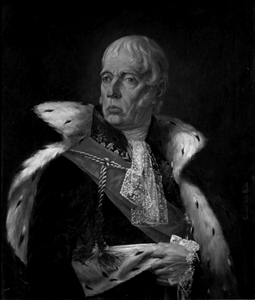General François Marie d'Aboville

Born: January 23, 1730
Place of Birth: Brest, Finistère, France
Died: November 1, 1817
Place of Death: Paris, France
Arc de Triomphe: DABOVILLE on the north pillar
Pronunciation:
A career artillery soldier, François-Marie d'Aboville first joined the artillery in March of 1744. He then became an aide-de-camp to his uncle General Julien d'Aboville and he participated in the War of the Austrian Succession. D'Aboville served in Flanders and during this time he fought at the Battle of Fontenoy and the Battle of Lawfeld. Less than a decade later he took part in the Seven Years War and he served at the sieges of Münster in 1759 and 1762. During that war he was also promoted to capitaine and after the peace was signed he was named a Knight of Saint Louis. D'Aboville next served in the regiment of La Fère and he obtained the rank of lieutenant colonel in 1778. In 1779 he became lieutenant colonel of the artillery of Besançon and then in 1780 he was sent with Rochambeau's expedition to take part in the American Revolutionary War. D'Aboville was promoted to colonel and he served as chief commander of the artillery, culminating in his service at the Siege of Yorktown in 1781. After returning to France in 1783, he took command of the artillery of La Fère in 1785. In 1788 d'Aboville was promoted to maréchal de camp.
With the arrival of the Revolution, d'Aboville was named a member of the military committee. In 1791 he was named inspector general of artillery. The next year he took command of the artillery of the Army of the North and he served at the Battle of Valmy. D'Aboville was named commander of the Army of the Moselle in February of 1793 but he did not take up the command, however he did serve as interim commander. In April of 1793 he stepped down as commander and took a position as a général de division. That July d'Aboville was suspended but in August the representatives of the people with the Army of the Moselle reinstated him in his position. In September he again was forced to step down and in November he was placed under horse arrest in Soissons for being a noble.
Suspicion was lifted from d'Aboville after Robespierre was overthrown in the Thermidorian Reaction, and in August of 1794 the Committee of Public Safety ordered d'Aboville to serve as the commissary overseeing supplies and logistics to support the operations of the Siege of Quesnoy. D'Aboville fulfilled this command and took part in the recovery of Quesnoy, Landrecies, Valenciennes, and Condé. At the end of the year he was reinstated in his rank of général de division. In 1795 d'Aboville was named inspector of artillery for Paris, Belgium, Holland, and the North.
In the year 1800 d'Aboville named the primary inspector general of artillery for the army. In 1802 he was named a senator and retired from the army, and the following year he served as vice president of the senate. In 1804 d'Aboville was rewarded with the Grand Eagle of the Legion of Honor and he traveled to Alessandria in 1804 to receive Pope Pius VII. In 1805 he commanded the National Guard of Doubs, Léman, and Jura. He continued to serve France, serving as governor of Brest for half of 1807 before returning to the senate. In 1808 d'Aboville was named a Count of the Empire and then in 1809 he took command of a division of the National Guard assembled at Brussels. He returned to the senate later that year. In 1812 d'Aboville once again supported the National Guard, organizing troops in the 6th military division. Two years later when Napoleon abdicated the throne, d'Aboville supported the incoming government and was named a Peer of France and Commander of Saint Louis. Both of his sons followed their father in artillery careers and served with distinction during the French Revolution and Empire.
Bibliography
Related Pages:
Updated August 2017
© Nathan D. Jensen